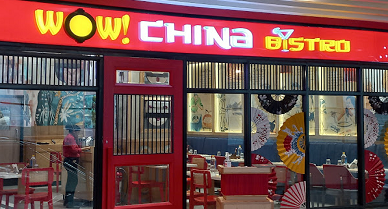China Bistro Judgement: A Detour From Established Principles?
INTRODUCTION
A single bench of the Delhi HC in Foodlink F & B v. WOW Momo Food (Wow Momo)[1] has injuncted the use of “WOW! China Bistro/ 

ESSENTIAL FEATURES
Admittedly, the single bench has applied the trite law of Kaviraj Pandit to facilitate the verdict of infringement. In Kaviraj Pandit, the Supreme Court (SC) held that in cases of infringement, if essential features of a trademark are adopted, cosmetic changes adopted by the defendant would be immaterial.[4] The purport here is that similarity between the two marks is ascertained on the anvil of visuals, phonetics or other aspects; so, when the essential feature is found, infringement is made out. In the present case, the single bench ascertained the essential feature from the textual matter present in the two composite marks. In order to do so, the single bench employed the use of K.R. Krishna Chettiar v Shri Ambal & Co. (Ambal).[5] In Ambal, the SC laid down the rule that determining essential features via an ocular comparison is not always the decisive test. The resemblance between the two marks must be considered with reference to the ear as well as the eye.[6] Therefore, the verdict of infringement was reached by following the dicta of Kaviraj Pandit & Ambal.
Having said that, the caveat here is three fold: Firstly, the determination of essential features in the present case is evidently different from the pre-existing jurisprudence. Secondly, notwithstanding the trite law on essential features, the exercise of comparison does not preclude the fact that the two competing marks must be seen as ‘a whole’.[7] And lastly, while an ocular comparison is not a stand-alone test to check for confusion, it must, however, not be excluded. Let us uncover these aspects.
In Phonepe Private limited v. EZY Services (Phone pe)[8], Delhi HC took the view that the word “pe” forms the essential feature in the mark ‘Phonepe’ since it is a non-dictionary word. Similarly, in the present case, the words “CHINA” & “BISTRO” are dictionary words making them non-distinctive and descriptive. Moreover, an argument could be tendered that reading the words “CHINA” & “BISTRO” as forming part of a wordmark, while excluding the device present therein (like the court did), does not make ‘CHINA BISTRO’ distinctive per se and it remains descriptive of the services. This caveat could be avoided if the descriptive mark is used for a long duration of time, thereby becoming distinctive.[9] Put differently, if the trademark ‘CHINA BISTRO’ were used for a long duration, the descriptive nature of the mark would have had no bearing on its acquired distinctiveness. Moreover, in such a scenario the essential elements would have been ‘CHINA BISTRO’. But this was not the case here. So when the word(s) in a trademark are descriptive (as in the present case), exclusivity can no longer be claimed.[10] Therefore, this brings into question the determination of essential features in the present case.
The court in Phone Pe also observed that seeing the common part of the words forming the competing marks may not be decisive and the overall similarity of the composite words is required to be seen. In other words, the two marks must be compared as a ‘whole’. Accordingly, if in Ambal the SC has noted that ocular test could not be the sole criteria for facilitating the conclusion of infringement, one could reasonably conclude (although with some authority) that the reverse should stand equally true: resemblance must be judged, in addition to phonetics, from an ocular test as well.[11] This brings us to the point of the average consumer test.
AVERAGE CONSUMER TEST
A trademark is protected in law when an infringing mark diverts customers from the source due to confusion.[12] And to determine confusion, the general impression of a mark upon a customer becomes a vital factor.[13] Herein there is huge import of the Anti-Dissection rule. The rule, within §17 of the Act, simply states that at the time of comparison, the two marks should not be dissected and must be seen as a ‘whole’.[14] The reason being that an average consumer remembers the impression a mark creates on him by recalling not the individual elements, but the impression in totality.[15] In the same token, it has been held as a violation of the anti-dissection rule to focus upon the “prominent” feature of a mark and decide the question of confusion solely upon that feature, ignoring all other elements of a mark.[16] However, this is not an absolute bar and sometimes, the court can look into the prominent features of a mark.[17] Having said that, in this case, the anti-dissection rule was applied.[18] Thus, the competing marks “WOW! China Bistro/

CONCLUDING REMARK
“The truth is that the label does not consist of each particular part of it, but consists of the combination of them all ”[24]
The aforesaid quote covers this post’s complete purport, barring the aspect of essential elements. As for it, it is questionable if a non-distinctive and descriptive part of a mark can become its essential element. More so, if that is true, there is some hesitation to conclude that upon comparing the two marks, the totality of impression is the same for both marks. Admittedly, the Single bench has delivered a prima facie decision based on evidence rendered. Despite that, the verdict could begrudgingly be questioned vis à vis the present jurisprudence.
Author: Sanchit Sharma, A Student at HPNLU, Shimla, in case of any queries please contact/write back to us at support@ipandlegalfilings.com or IP & Legal Filing
[1] CS(COMM) 848/2022 (Wow Momo).
[2] (2) A registered trade mark is infringed by a person who, not being a registered proprietor or a person using by way of permitted use, uses in the course of trade, a mark which because of—
(a) its identity with the registered trade mark and the similarity of the goods or services covered by such registered trade mark; or
(b) its similarity to the registered trade mark and the identity or similarity of the goods or services covered by such registered trade mark; or
(c) its identity with the registered trade mark and the identity of the goods or services covered by such registered trade mark, is likely to cause confusion on the part of the public, or which is likely to have an association with the registered trade mark.
[3] Wow Momo, Supra note 1, at para 18.
[4] Kaviraj Pandit Durga Dutt Sharma vs. Navaratna Pharmaceutical Laboratories AIR 1965 SC 980, para 28.
[5] K.R. Krishna Chettiar v Shri Ambal & Co. 1970 AIR 146.
[6] Ibid, para 7.
[7] Ibid, para 29; M/S S.M. Dyechem Ltd vs M/S Cadbury (India) Ltd 2000(5) SCC 573; K.R. Krishna Chettiar v Shri Ambal & Co. 1970 AIR 146.
Pidilite Industries Limited v. Jubilant Agri & Consumer Products Ltd. 2014 (57) PTC 617 (Bom); M/S South India Beverage Limited v. General Mills Marketing Inc; Phonepe Private limited v. EZY Services
[8] 2021 SCC OnLine Del 2635.
[9] Marico Limited v. Agro Tech Food Limited (2010) 44 PTC 736 (Del.) (DB)at para 15-17; Phone Pay
[10] Rich Products Corp v. Indo Nippo Food Ltd. 2007 (35) PTC 15 Del.
[11] Phone pe, Supra note 8, at para 21.
[12] Ellora Industries v. Banarasi Dass Gupta; AIR 1980 Del 254.
[13] Seixo v. Provezende (1866 LR 1 Ch. 192).
[14] M/S South Indian Beverages Pvt. Ltd. v. General Mills Marketing Inc. (2015) 61 PTC 231. See also: https://www.khuranaandkhurana.com/2023/03/16/delhi-hcs-subway-judgement-when-is-a-trademark-not-seen-as-whole-part-i/#_ftn17
[15] Stiefel Laboratories v. Ajanta Pharma Ltd. para 23.15
[16] Ibid.
[17] Supra note 14, South Indian Beverages, at para 19.
[18] Supra note 1, Wow Momo, Para 46
[19] ILR 1952 Bom 344
[20] Ibid, para 10.
[21] 2018 (76) PTC 365 (Cal).
[22] Ibid.
[23] Phone pe, Supra note 8, at para 77.
[24] Pinto v. Badman [8 RPC 181].



